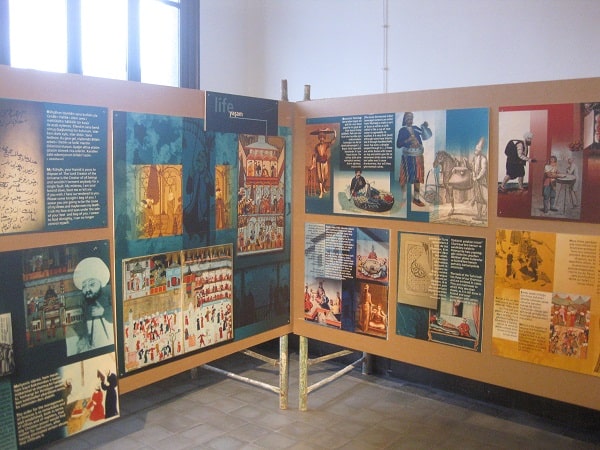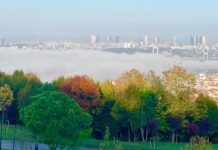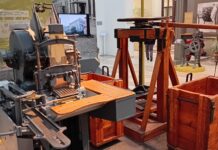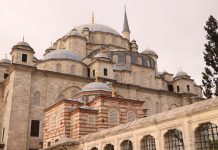
Artifacts have been found in Istanbul (previously home to some of the world’s largest empires, the city has also been known as Byzantion, Nea Roma, Constantinople, Kostantiniyye, and Islambol) dating back 8000 years. Yet much of this prehistory is unknown to the general public.
The Tarih Vakfı (History Foundation) has reintroduced the city to its prehistorical, Roman, Byzantine, and Ottoman past through the exhibition “Again and New: World City Istanbul” currently on display at the Galata Rum (Greek) School in Karaköy. I mention that they have reintroduced Istanbul’s public to its older, unknown history because this exhibition has been previously staged at the Darhane-i Amire building in the courtyard of the Topkapı Palace in 1996.
The building that is holding the exhibition, the Galata Rum School, is quite a piece of art itself. Located only a 10 minute walk from the Karaköy Lokantası and across from the Getronagan Armenian church, which gives you a sense of the area’s former diversity, the Galata Rum School has not had Greek students since the 1980s. The school has wonderful Greek-revival columns in the front and is at least 4 stories high.
The exhibition is organized through a series of panels arranged chronologically from the earliest prehistorical times to the 1990s. Additionally, in the large front auditorium of the school there are enormous scaled models of Istanbul from the European and Asian perspectives of the city. By viewing the models at the entrance to the exhibition, you can get a sense of the enormity of the city as well as how it has changed over the centuries.
On the second floor of the school is where the panels begin. Here they show the artifacts found from a variety of civilizations that have made the Marmara Sea basin their home during the past thousands of years. Panels describing the Roman and Byzantine contributions to the city are also displayed on this level. The exhibition organizers included a model of Byzantine Constantinople (as it was known then), which allows visitors to get a sense of the wealth and immense control the Byzantines commanded during their peak. Additionally, from this level you can see above the auditorium to a wall opposite the exhibition room. Here Byzantine mosaics are projected from a video screen. I think the addition of the Byzantine contribution is an important one, and one that is often ignored or neglected.
The period around the conquest of Istanbul in 1453 by Sultan Mehmet the Conqueror is the topic of the continuation of the exhibition on the third floor of the school. The exhibition describes the commercial relations within the city and shows in what ways the city changed (and in what way it remained the same) as a result of the Ottoman influence.
Finally, the exhibition describes the transition from the Ottoman Empire to the Turkish Republic and the changes that have happened to Istanbul during this period. It describes the way the city had changed throughout the century, from immigration, migration and urban development, to the cultural activities and how public space has been used by various groups during the last few decades. The last panels display the dominant architectural styles of the modernist era. The exhibition ends in the 1990s, which is when it was originally exhibited.

One of the strengths of “Again and New: World City Istanbul” is the visuals on display throughout the exhibition. These are taken from the last 2000 years of Istanbul’s history, many of which I had not seen before. Another impressive aspect was the use of a variety of quotes taken from numerous different sources throughout the history of the city. These primary source materials really add dimension to what you are seeing and what we know about the city. For instance, quotes like the one below really helped to create a richer picture:
There are in Constantinople, and in all of Turkey, some public buildings instead of inns which they call Karavan Serais (Kervanseray)or Kans (Hans) built in several locations of the city as Markets or public places where many commodities are sold. All sorts of people from all walks of life and from all countries are received there; the poor have a room to lodge, and the rich haven’t much more, so that one has to bring his bed and provision if one doesn’t want to sleep in the streets, or at the most on a straw-mat which the Porter has to provide in some Kans. —Sir George Wheler (1650-1723)
One drawback is that it does not have a panel about the conquest of Constantinople in 1453 and how that impacted the city architecturally. It just moves from the Byzantine to Ottoman Empire without any detailed depiction of this event. Also, because it ends in the 1990s, there is not an extensive discussion or analysis of the environmental impact the population growth of Istanbul has caused nor any long term feasibility studies and projections of how the city could possibly look in the next 25 years.
Overall, “Again, and New: World City Istanbul” does an excellent job showing the history of the city during the past 8000 years through a series of panels depicting the visual, cultural, and architectural legacy of the various cultures and civilizations that have made the city home. Two major themes stand out: First, that trade and commerce due to the location of Istanbul have made it an extremely attractive prize and possession for numerous empires throughout history. Second, empires such as the Romans, Byzantines, and Ottomans influenced each other in a myriad of ways, resulting in a religious and cultural syncretism. Although it is practically impossible for any one exhibition to do justice to a city that has experienced such a tumultuous history, “Again and New: World City Istanbul” does it’s best to show why Istanbul is so exceptional, a true “City of Cities”.
Galata Greek School
Kemealtı Caddesi No. 49, Karaköy
Wednesday, 15 January – Saturday, 22 February 2014
Open from 11:00-19:00 (closed on Mondays)
Free Admission
Kosta Dalageorgas is a contributor to Yabangee











[…] Yabangee – 8000 Years of Istanbul: Review of ‘Again, and New: World City Istanbul’. […]